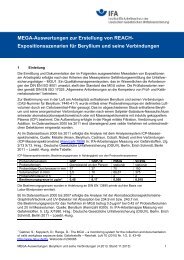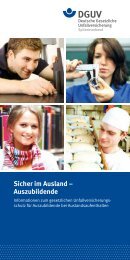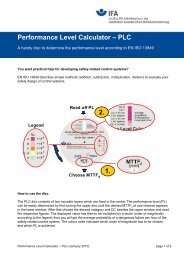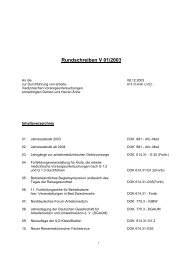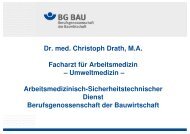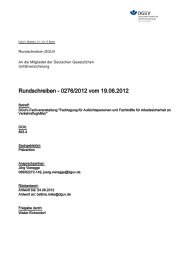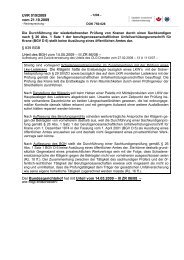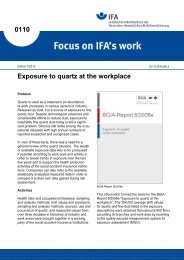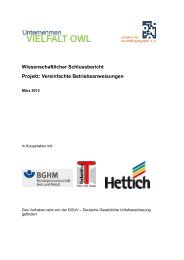Effectiveness of measures to prevent needlestick injuries among ...
Effectiveness of measures to prevent needlestick injuries among ...
Effectiveness of measures to prevent needlestick injuries among ...
Create successful ePaper yourself
Turn your PDF publications into a flip-book with our unique Google optimized e-Paper software.
8 Bibliography<br />
A retrospective study <strong>of</strong> systematically registered exposure during the period 1990-<br />
1994]. Ugeskr. Laeger 158 (1996) no. 13, p. 1807-1811<br />
[31] Nelsing, S.; Nielsen, T. L.; Nielsen, J. O.: Percutaneous blood exposure <strong>among</strong><br />
Danish doc<strong>to</strong>rs: exposure mechanisms and strategies for <strong>prevent</strong>ion. Eur. J. Epidemiol.<br />
13 (1997) no. 4, p. 387-393<br />
[32] Trim, J. C.: A review <strong>of</strong> needle-protective devices <strong>to</strong> <strong>prevent</strong> sharps <strong>injuries</strong>. Br. J.<br />
Nurs. 13 (2004) no. 3, p. 144, 146-153<br />
[33] Orenstein, R.; Reynolds, L.; Karabaic, M.; Lamb, A.; Markowitz, S. M.; Wong, E.<br />
S.: Do protective devices <strong>prevent</strong> <strong>needlestick</strong> <strong>injuries</strong> <strong>among</strong> health care workers? Am.<br />
J. Infect. Control 23 (1995) no. 6, p. 344-351<br />
[34] Sohn, S.; Eagan, J.; Sepkowitz, K. A.: Safety-engineered device implementation:<br />
does it introduce bias in percutaneous injury reporting? Infect. Control Hosp.<br />
Epidemiol. 25 (2004) no. 7, p. 543-547<br />
[35] Sohn, S.; Eagan, J.; Sepkowitz, K. A.; Zuccotti, G.: Effect <strong>of</strong> implementing safety-<br />
engineered devices on percutaneous injury epidemiology. Infect. Control Hosp.<br />
Epidemiol. 25 (2004) no. 7, p. 536-542<br />
[36] Mendelson, M. H.; Lin-Chen, B. Y.; Solomon, R.; Bailey, E.; Kogan, G.;<br />
Goldbold, J.: Evaluation <strong>of</strong> a safety resheathable winged steel needle for <strong>prevent</strong>ion <strong>of</strong><br />
percutaneous <strong>injuries</strong> associated with intravascular-access procedures <strong>among</strong><br />
healthcare workers. Infect. Control Hosp. Epidemiol. 24 (2003) no. 2, p. 105-112<br />
[37] Alvarado-Ramy, F.; Beltrami, E. M.; Short, L. J.; Srivastava, P. U.; Henry, K.;<br />
Mendelson, M.; Gerberding, J. L.; Delclos, G. L.; Campbell, S.; Solomon, R.; Fahrner,<br />
R.; Culver, D. H.; Bell, D.; Cardo, D. M.; Chamberland, M. E.: A comprehensive<br />
approach <strong>to</strong> percutaneous injury <strong>prevent</strong>ion during phlebo<strong>to</strong>my: results <strong>of</strong> a<br />
multicenter study, 1993-1995. Infect. Control Hosp. Epidemiol. 24 (2003) no. 2,<br />
p. 97-104<br />
[38] Evaluation <strong>of</strong> safety devices for <strong>prevent</strong>ing percutaneous <strong>injuries</strong> <strong>among</strong> health-<br />
care workers during phlebo<strong>to</strong>my procedures – Minneapolis-St. Paul, New York City,<br />
Report „Needlestick <strong>injuries</strong>“ 78





